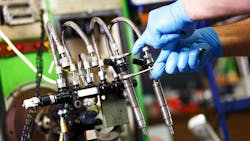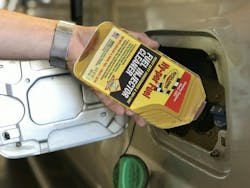Fuel and filter quality, as well as following OEM guidelines for fuel system maintenance, play a key role in keeping engines running efficiently and reliably. Vehicle maintenance teams also should be careful not to overlook the importance of fuel injectors, designed to keep the fuel supply running smoothly. When an injector experiences a problem, the whole engine suffers the consequences.
“Injector operation is required for not only efficiency but also emissions standards as well,” said Chad Six, Ohio Valley regional supervisor, maintenance operations, transport & rail, at Marathon Petroleum.
It helps that the system itself typically handles injector upkeep.
“Fuel injectors are lubed and cleaned by diesel fuel during normal operation,” Six said. “As this is done under normal operation, they don’t become dirty or need to be removed and cleaned.”
But injectors are not only utilized for engine operation, Six stated. “Emissions system components rely on fuel to catalyze and clean the diesel particulate filter,” he said. “If fuel injector operation is compromised, so is the efficiency of the emissions system.”
Six added that general engine maintenance goes a long way to ensure this happens consistently, saying “fuel injector filtration and fuel quality are important for [an injector’s] life cycle.”
Brad Queen, content group manager and vehicle electronics specialist at Noregon, agreed.
“Fuel quality plays an important role in the operation and longevity of fuel injectors,” Queen, an ASE-Certified Master Technician, said. “Higher-quality fuel improves injector reliability and causes less wear on components, limits corrosion from water intrusion, and provides better performance and fuel mileage across the entire fuel system due to better combustion than poorer quality fuel.”
Mark Ulrich, Cummins director of customer support, noted the leading diesel engine manufacturer does not have specific diesel injector maintenance requirements aside from ensuring the fuel and filters are up to snuff.
“For best fuel system performance and health, we recommend customers follow prescribed fuel filter maintenance intervals with the correct micron filter ratings as outlined in the Cummins operation and maintenance manual for a given engine product,” he stated. “We have not been made aware of any issues with our fuel system components when fleets use commercially available sources of fuel. Following these guidelines ensures that engines meet needs and expectations on performance, efficiency, and reliability”.
But what happens when diesel injectors start to underperform?
“Diesel injectors are crucial for engine efficiency, and dirty injectors can cause poor combustion, reducing performance and increasing fuel consumption,” Scott Meek, diesel training director at Diesel Laptops, said. “Low-quality fuel can clog injectors, speeding up wear and lowering reliability, so clean, high-quality fuel is essential for maintaining injector efficiency.”
Noregon’s Queen pointed out that the buildup of internal and external deposits in diesel injectors can lead to a variety of problems. Those include weakened or total loss of engine power, decreased fuel economy, and an increased need for regens due to high soot levels.
Dirty or malfunctioning fuel injectors can also affect engine longevity, noted Clay Parks, VP of development at Rislone. “If injectors are not spraying fuel as a fine atomization—like fuel droplets—the fuel will not completely burn, and it will either be pushed out the exhaust or some of it will end up in the oil,” he explained. “That also reduces the life of the engine and emissions components. A dirty or defective fuel injector should give fleet managers many concerns.”
Diagnosing injector issues
Just as injectors have many benefits, they can also fail in several ways, Marathon’s Six said.
“They can fail internally in the seat of the injector and not atomize fuel correctly, leak by returning too much fuel, and ‘dribble’ or have compression pass through,” the maintenance manager explained. “This will allow compression from the piston to introduce air into the fuel system return.”
The injector O-rings at the cylinder head can also fail and lead to internal fuel leaks, Six continued.
An electronic failure could also occur where the injector meters how much fuel feeds the cylinder. These can be difficult to predict, and according to Six, “electronics can fail at any time for any reason.”
But how can you tell what’s wrong and why?
“Injector problems require visual checks, performance tests, and electronic diagnostics,” Dan Nynas, chief operating officer at Diesel Laptops, explained. “Using advanced tools can pinpoint issues early, preventing bigger engine problems.”
Read more: Decoding historical data with diagnostics and VMRS codes
With a combination of OEM or aftermarket software, injector flow and spray pattern testing, as well as sending out injectors to be tested, fleets can diagnose injector problems, noted Rislone’s Parks.
Not all shops stock these tools, though, Six noted.
“That being said, diagnostic software is required to set trim codes when or if a fuel injector is replaced,” Six added. “The trim code tells the engine control module where that injector metered so if just one is replaced, it knows how to meter and balance that injector to the rest.”
The diagnosis will also depend on the failure point, Six said. “If the injector fails, the standard cylinder cut-out test would be the first diagnostic procedure,” he stated. “If the problem is a low efficiency, drivability, or fuel usage issue, a cylinder balance test would be the procedure to utilize to see if the injectors are atomizing fuel correctly.
“A cylinder contribution test can also be run to identify the same issue as well as a leaking O-ring seal,” he continued. “After these tests are done and proper diagnosis is established, the failed injector should be inspected to see if the electrical connections are intact, and nothing abnormal is seen on the surface.”
Noregon’s Queen recommended using an advanced diagnostic tool, such as a troubleshooting module, that guides the users down a series of procedures until the root cause of the issue is discovered.
Cleaning and replacing injectors
By keeping up on preventive maintenance, fleets can stay ahead of injector issues.
There are a number of factors that come into play when determining how often fuel injectors should be cleaned and/or replaced, and it will vary by fleet.
“Cleaning and replacement intervals depend on engine type, conditions, and fuel quality,” Meek said. “Typically, injectors should be serviced every 20,000 to 30,000 miles.”
Chris Johnson, business development manager at Diesel Laptops, recommended using ultrasonic cleaners and flow testers “to ensure thorough cleaning” as well as high-quality cleaning solutions.
Employing premium cleaners at regular intervals will help injectors stay clean and improve their lifespan, Rislone’s Park noted.
“We recommend an injector cleaner that includes a top lube to prevent sticking and allow greater power and performance,” he added.
Fortunately, avoiding O-ring issues requires far less frequent attention.
“Removing and re-sealing the injector O-rings should be completed around the 500,000-mile mark, but most fleets do not perform this task if there is no issue,” Six noted. “The standard practice is to replace the failed injector, and on high-mileage vehicles, it makes sense to replace all injectors. If one is worn out, the rest are more than likely to fail as well.”
When replacing a fuel injector, Noregon’s Queen said it is important to ensure that you program the new one correctly.
“This is often overlooked because not all OEs require programming codes, but even in instances where the engine seems to run fine, there could be a decrease in fuel economy due to not being properly programmed,” he explained further. “Shops should give technicians step-by-step instructions for removing the old injector and installing the new one.”
Realizing performance improvements
While exact numbers could vary depending on how a fleet uses its diesel equipment or trucks, keeping injectors clean could provide a 2-5% fuel economy improvement, Clay Parks noted.
“Fleets can quantify the benefits of keeping injectors clean by considering the consequences,” Noregon’s Queen said. “When an injector can’t function properly, the risks include roadside breakdowns, unsafe driving conditions, and increased fuel consumption.”
“Clean injectors can boost fuel economy by as much as 5% to 10%, depending on conditions,” Mark Lipinski, diesel tech trainer at Diesel Laptops, stated. “They also reduce engine wear, lowering maintenance costs and extending component life. Over time, this translates to significant savings for fleets.”
About the Author

Seth Skydel
Seth Skydel, a veteran industry editor, has more than 36 years of experience in fleet management, trucking, and transportation and logistics publications. Today, in editorial and marketing roles, he writes about fleet, service, and transportation management, vehicle and information technology, and industry trends and issues.

